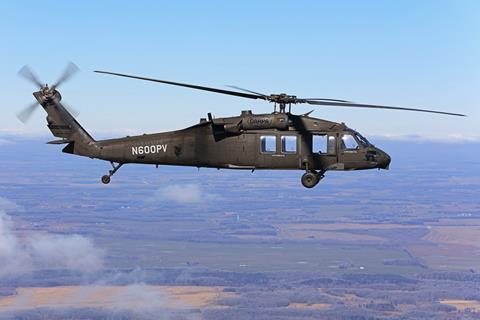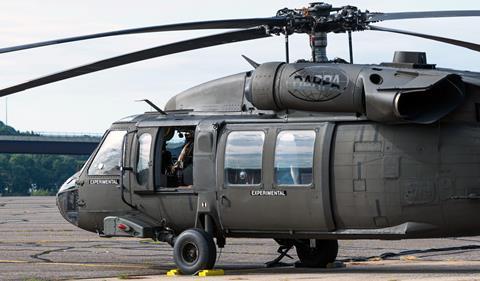Rotorcraft manufacturer Sikorsky will modify a US Army-owned UH-60 Black Hawk with autonomy technologies that will allow for single-pilot or fully pilotless flights.
Sikorsky has been awarded a $6 million grant from the US Defense Advanced Research Projects Agency (DARPA) to install the company’s Matrix autonomous flight package into an existing UH-60M. That aircraft has already been modified with an experimental fly-by-wire flight control system, a necessary feature for the Matrix package.
The new autonomous-capable aircraft will be designated the “MX” for testing and evaluation.
“The upgraded aircraft will enable the US Army Combat Capabilities Development Command (DEVCOM) to test and evaluate a wide range of autonomy capabilities, from single-pilot operation to fully uninhabited flight,” Sikorsky said at the 2024 Association of the US Army (AUSA) conference in Washington, DC on 14 October.
Rather than invent new technology for the MX project, Sikorsky will essentially replicate its company-owned UH-60A Optionally Piloted Vehicle (OPV) – a modified Black Hawk that already has been flying for several years.

DARPA and Sikorsky logged the first fully autonomous sortie with the OPV Black Hawk in 2022, including two flights without any pilot onboard. Previous tests had included a human aviators as a safety back-up.
That platform has now logged several hundred flight hours, according to Sikorsky.
Notably, Sikorsky chose an older A-model UH-60 for the OPV project to demonstrate that even well-aged rotorcraft can be outfitted with the Matrix technology.
Additions to enable pilotless flight include a separate flight computer, a suite of sensors to provide data to that computer, and replacing mechanical flight controls with a digital fly-by-wire control system.
Under the DARPA programme that developed Matrix, that fly-by-wire system was installed in a UH-60M in 2020. That same aircraft will be modified again with the remaining Matrix systems to create the autonomous-capable MX Black Hawk, which Sikorsky describes as a “near-exact copy” of the OPV aircraft.
Integration work will take place in 2025, after which DEVCOM will evaluate the autonomy technology for maturity and scalability, according to Sikorsky. Those evaluations will include assessing the ability of different sensor suites to perceive and avoid threats, obstacles and terrain.
Speaking at AUSA, Sikorsky’s advanced concepts business director Ramsey Bentley noted the autonomous MX will be able to do much more than just point-to-point navigation.
“The aircraft is actually intelligent,” Bentley says. “It is able to avoid threats [and] it’s able to do dynamic re-tasking, all with the autonomy onboard the aircraft
“It can do that without human intervention,” he adds.
At a time when low-flying rotorcraft are more vulnerable than ever on the battlefield, Sikorsky is pitching the Pentagon on the concept of a fully-autonomous Black Hawk that can be used in conditions assessed as too dangerous for a crewed flight.

Known formally as “contested logistics”, such missions could include resupplying ground combat troops in insecure areas or casualty evacuation under fire. Even the US Army’s relatively ill-equipped opponents in Iraq and Afghanistan were able to create conditions when casualty evacuation or aerial resupply were deemed too risky for landing a helicopter near troops in contact.
Modern adversaries equipped with guided anti-aircraft missiles make that prospect even riskier. An autonomous Black Hawk offers the tantalising prospect of being able to fly those missions, without risking onboard personnel.
“Having those options, I think, will really make a difference,” Sikorsky’s Jay Macklin told FlightGlobal in July.
Macklin commanded an army aviation task force in Iraq during combat operations from 2007-2009. He now oversees business development for Sikorsky’s US Army and US Air Force portfolio.
“I had to put two crews in harm’s way on an extremely high-risk mission,” Macklin recalled of his time in Iraq. “If I had this technology, I literally would have programmed one aircraft to pick up, fly, land and come back.”
In a less extreme case, Sikorsky’s autonomy technology could be used to assist human pilots in cockpit or even reduce the number of aviators needed to fly.
“Autonomy-enabled aircraft will reduce pilot workload, dramatically improve flight safety and give battle commanders the flexibility to perform complex missions in contested and congested battle space, day or night in all weather conditions,” says Rich Benton, who took over as the head of Sikorsky in June.
A more-limited version of that capability is already incorporated in Sikorsky’s CH-53K King Stallion heavy-lift helicopter; the system allows the rotorcraft to assist pilots with landing in low-visibility conditions, such as at night or amid rotor-wash brownouts.
Although the US Army has selected Bell to design and deliver its next-generation Future Long-Range Assault Aircraft (FLRAA) tiltrotor, the service is still buying new UH-60s and plans for those aircraft to be flying for at least the next three decades.
If the MX technology demonstration proves effective, it raises the potential for the army to quickly and cheaply convert some or all of the service’s more than 2,100 Black Hawks into autonomous-capable aircraft to serve alongside the FLRAA.
“Soldiers will rely on Black Hawk helicopters into the 2070s,” Benton says. “Modernising the aircraft today will pay dividends for decades across army aviation’s current and future aircraft.”

































